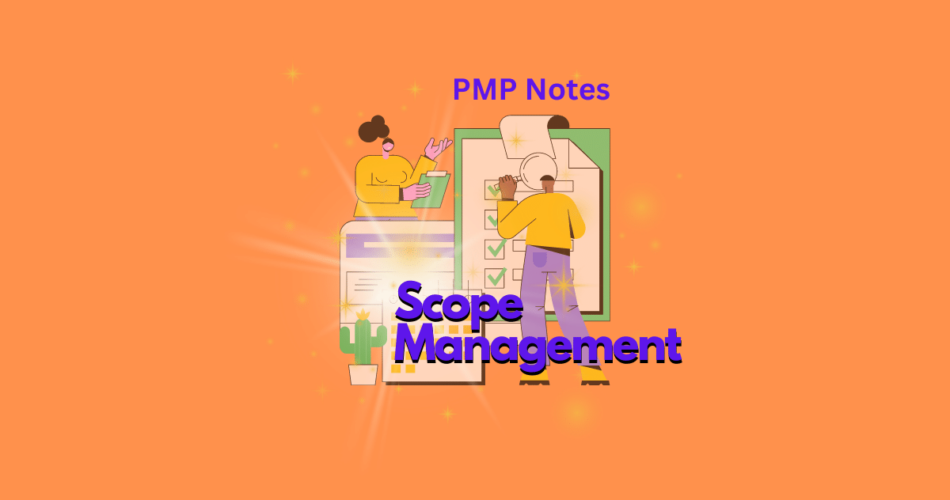Scope issues are a major reason a project fails. Every project needs scope management. Without a scope management plan, stakeholders assume the project is in their favour, leading to unexpected results. The project manager must clearly define its scope to ensure a smooth project.
Definition of Scope Management Plan
A scope management plan is put together to guarantee that the project includes everything that needs to be done to finish it but leaves out everything that isn’t. A project’s scope management plan’s primary function is to outline how the project’s scope will be explained, developed/structured and verified.
According to the PMBOK: “Managing project scope is primarily concerned with defining and controlling what is and is not included in the project.”
Scope First, the scope can refer to either a product's or a project's scope. It is essential to understand the distinction: Product scope is defined as a product's or service's functions and characteristics. Project scope is the work required to deliver a product in accordance with the product's scope (required functions and features) The project scope is the consensus among stakeholders regarding the project's components and the success factors. The functionalities or specifications outlined in a project's requirements comprise its scope.
Scope creep
Scope creep is annoying. Scope creep occurs when project changes aren’t managed. Imagine adding new requirements to a completed project. Scope creep happens when new requirements aren’t reviewed and delivered as planned.
Another example of scope creep is when many project changes are approved. Yes? Not if those changes, approved or not, create an endless project.
Plan against project scope creep. That’s why a scope management plan is essential.
Exercise 1.0
Game development scenario to understand project and product scope
- Programming
- 34 levels in the game
- Graphic design
- Four playable characters
- Great graphics
- Testing
- Mac and PC compatible
- A “Boss Battle” fight level at the end of the game
Answers
Project Scope: 1,3,6
Product Scope: 2,4,5,7,8
Project scope statement
The scope is documented in a project plan’s scope statement. And what exactly is a scope statement? It’s a document that guides future project decisions. The scope statement is clear (the work required). The rest is irrelevant. What does project scope mean? Anything outside the scope statement’s required functionalities and specifications.
What does the management of a project’s scope entail?
The procedure of constructing the scope statement begins here. The PMBOK identifies six main processes as part of scope management for controlling and outlining a project’s boundaries. These are
- Planning scope management: The project plan, charter, and stakeholder input are used to develop a scope management plan.
- Collecting requirements: Based on the Scope Management Plan and Stakeholder Input, Develop a Requirements Management Plan. We will conduct interviews, focus groups, surveys, and more to learn what is needed. Each step will be recorded for posterity.
- Defining scope: We define the scope by compiling all requirements documentation, the project charter, and the scope management plan into a project scope statement. Each step of the project will be based on this definition.
- Creating the Work Breakdown Structure: WBS development follows an analysis of the project scope statement and the requirements documentation. The WBS is a detailed breakdown of the entire project into manageable chunks, with each task and its associated deliverables specified.
- Validating scope: Deliverables are inspected and evaluated during the validation of scope. Either they are accepted as complete, or they require further revisions.
- Controlling scope: As the project is carried out, the scope must be controlled. As a result of comparing performance reports to project requirements to determine where gaps exist, the project plan may be modified.
Exercise 2.0
| The game must have fewer than 15 defects per 10,000 lines of code. | Project exclusions |
| There will be four graphic designers reporting to the art director, and six programmers and four testers reporting to the development manager | Project deliverables |
| No more than 15 people can be allocated to work on the game at any time. | Project constraints |
| Scenery artwork. | Project assumptions |
| The product will not include bug fixes for the previous version. | Project requirements |
| The game needs to run on a machine with I GB of memory or less. | Acceptance criteria |
Answers: 1=F, 2=E, 3=C, 4=B, 5=A, 6=E
Guide to Developing a Scope Management Strategy
The following steps must be taken to develop a “Scope Management Plan”:
- Inputs: Typically, inputs include the project charter, project management plan, etc.
- Tools and techniques: typically includes concepts such as meetings, analytics, and decision-making, among others.
- Outputs – These typically consist of processes designed to optimize the scope management plan, requirements management plan, etc.

Steps for Creating a Scope Management Plan
The following are the steps to creating a scope management plan:
- Identify stakeholders and obtain their requirements.
- Produce a detailed project scope statement outlining the project’s goals and objectives.
- Create a work breakdown structure (WBS) to map out all tasks that must be completed.
- Create a process for maintaining and approving the WBS.
- Outline the project team’s roles and responsibilities.
- Establish a formal process for accepting completed project deliverables.
- Figure out how to manage and document change requests in relation to the scope statement.
Project: Scope vs Requirement Document
The following are the goals of the SCOPE MANAGEMENT PLAN.
- How will the Acceptance Criteria be derived?
- Who needs to be involved in creating a complete and error-free Work Breakdown Structure?
- How do we handle changes to the work breakdown structure?
- Who will be reviewing and approving? How do we handle changes in project scope in general?
- How do we create an effective project scope statement?
The following are the goals of the REQUIREMENTS MANAGEMENT
- Traceability of requirements and tracking implementation against the plan
- How do we handle changes, missed requirements, and additional requirements?
- Sorting out the requirements – “nice to have” vs “must-have”
- How do we measure and verify that the project is on track and meeting the requirements?
What is MoSCoW Prioritization?
MoSCoW prioritization is a popular requirement management technique.
MoSCoW stands for must-have, should-have, could-have, and won’t-have. Some companies use MoSCoW’s “W” for “wish.”
While working at Oracle, software development expert Dai Clegg developed the MoSCoW method. He created the framework to assist his team in prioritizing tasks during product development.
MoSCoW prioritization how?
A few things must happen before running MoSCoW. First, stakeholders and the product team must agree on objectives and priorities.
Then, all participants must prioritize initiatives. Your team should also discuss how to settle prioritization disagreements. If you can resolve disputes before they arise, you can help progress.
Finally, decide how much resources to allocate to each category.
After laying the groundwork, you can decide which category best fits each initiative. First, break down each MoSCoW category.
You can read more about MoSCoW technique here
Exercise 3.0
- The work required to create the graphics
- New characters in the game
- 18 new levels
- The performance requirements for the product
- A description of how the WBS is created
- How will the software be tested
- How will the stakeholders verify the deliverables?
- A list of all artwork that will be created
Answers
Requirements document: 2,3,4,8
Project scope statement: 1,5,6,7
What are the various ways in which you collect the requirements?
- Unanimity means everyone agrees on the decision.
- Majority means that more than half the group members agree on the decision.
- Plurality means that the idea that gets the most votes wins.
- Dictatorship is when one person decides for the whole group.
Exercise 4.0
- The group voted on a new feature five times but decided not to include it in the game because they couldn’t get everyone to agree.
- The VP of Engineering told everyone that they had to come up with a new character for Team “cute cow”. Since he was the highest-ranking person in the room, nobody argued with him.
- There were ten new scenery suggestions for approval, but only five could make it into the game. The team chose the top five in a general vote.
- Over half the group wanted to see a new story that involved a zombie cow. So that requirement was recorded as an absolute necessity
1=Unanimity I 3=Plurality I 4=Majority I 2= Dictatorship
WBS example
You can see a work breakdown structure created for a birthday [arty.

You can read my notes on Risk management here




